When it comes to microelectromechanical systems (MEMS)-based displays, what’s old is new — and now the only game in town. The old, and now only, technology involves projectors, which exploit MEMS chips to create images by bouncing light off either an array of tiny mirrors or a single microscopic mirror. Some of these displays are as big as movie screens. Others are small, near-eye displays. Still others are in-between, such as head-up displays in cars.
What are no longer around, at least commercially, are display technologies based on MEMS interferometric modulators and shutters, such as Qualcomm Inc.’s Mirasol and Pixtronix. San Diego-based semiconductor and telecommunications equipment maker Qualcomm quietly abandoned its MEMS-based display efforts in mid-2015 after years of trying to develop a viable business.
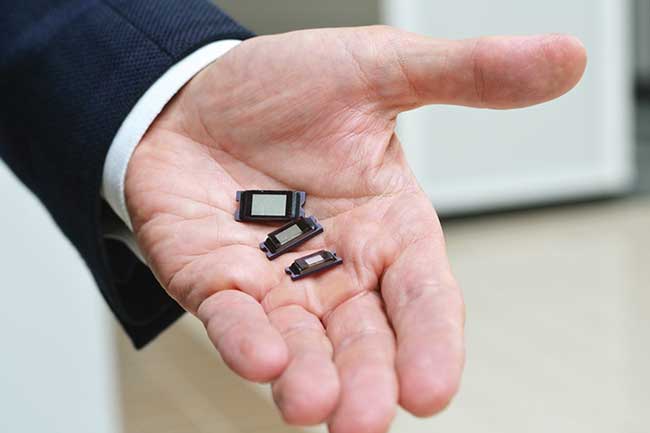
Manufacturing advances have resulted in smaller MEMS feature sizes, which in turn means that projection display chips have gotten smaller. Courtesy of Texas Instruments Inc.
“The main problem was that they compete against LCD flat panels, which have been in huge volume production for a long time. MEMS flat panel displays are much more expensive to manufacture,” said Jérémie Bouchaud, senior principal analyst for MEMS & Sensors at market and technology research firm IHS Markit Ltd.
The abandoned technology did create high-quality images, consume little power and work in bright sunlight — all important attributes for mobile applications. In the end, though, the price differential proved too much, Bouchaud said.
Projection technologies, on the other hand, are still going strong, with the market forecast to grow from $823 million in 2015 to $1.02 billion in 2019 according to IHS Markit. Bouchaud said that growth will be due to an expansion of picoprojectors. These attach to or are part of a phone, tablet or computer. They create a display on a nearby wall or other surface that can be viewed by a group.
Picoprojectors have been around for years, but their adoption in smartphones has been somewhat stymied by the advent of tablets and phones with bigger screens. Recent advances in resolution and other characteristics of MEMS-based display technology, however, promise to improve the appeal of picoprojectors. Those same developments could help power head-up and near-eye displays.
An example of these improvements comes from Texas Instruments (TI). The Dallas-based semiconductor company debuted its digital micromirror technology, now called DLP technology, decades ago. In the devices, a mirror measuring microns across is attached to a hinge and rotates on demand in response to an electrical signal, allowing individual pixels to be on or off.
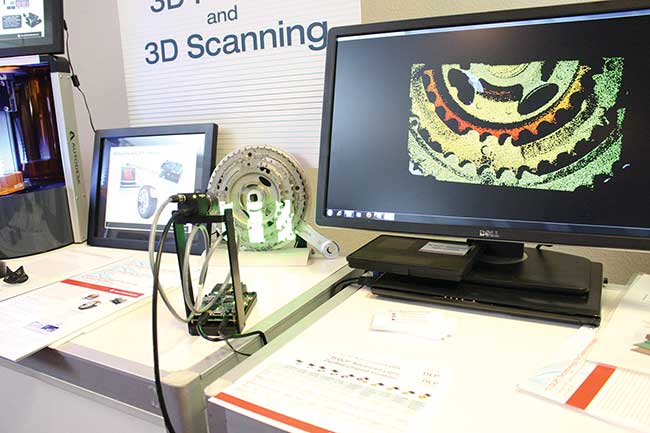
A MEMS digital micromirror device, camera and other peripherals enables 3D scanning through the use of structured light. Courtesy of Texas Instruments Inc.
Smaller form factor
At one time the cell size was 13 microns. Now it’s 5.4 microns, said Kent Novak, senior vice president and general manager for DLP Products at TI.
“What that allows us to do is clearly put more resolution inside a smaller form factor. That’s one of the enabling technologies,” he said.
The smaller pixel size makes it possible to cost-effectively manufacture a 4K chip, according to Novak. This means the resolution of the projected image is roughly 4000 pixels in the horizontal and 2000 pixels in the vertical, a more than fourfold increase over high definition, which comes in at about 1000 pixels in the vertical.
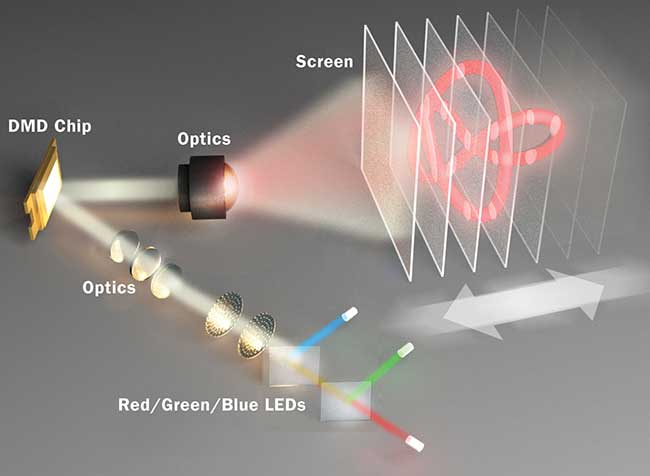
MEMS-technology can create 3D displays by maintaining image quality over several centimeters in depth. Courtesy of Optecks.
Several other innovations should also contribute to expanding the MEMS-display market. One is an increase in the image intensity, with picoprojector lumens rising from about 8 lumens per watt several years ago to 25 now, leading to an output of up to 1000 lumens. That makes the projected image more readily visible in varied settings.
Another advance is better optics and optical engineering, which together lead to a decrease in the distance between the projector and display surface. It’s now possible to put a MEMS-based projector 12 inches away from a wall and then create a 70- or 80-inch image on it, Novak said.
In Texas Instruments’ case, a projection display uses an array of millions of micromirrors. A different approach is to use a single MEMS mirror and red, green and blue lasers, with the combination rapidly moving a point through space to trace out an image.
That’s the concept behind MEMS-based displays from Redmond, Wash.-based MicroVision Inc. Thanks to faster scanning speed, the company’s products have quadrupled in resolution over the past few years, said Dawn Goetter, director of marketing communications for MicroVision. She added that they also have more than doubled in brightness from 15 to 32 lumens, but that doesn’t convey the whole story.
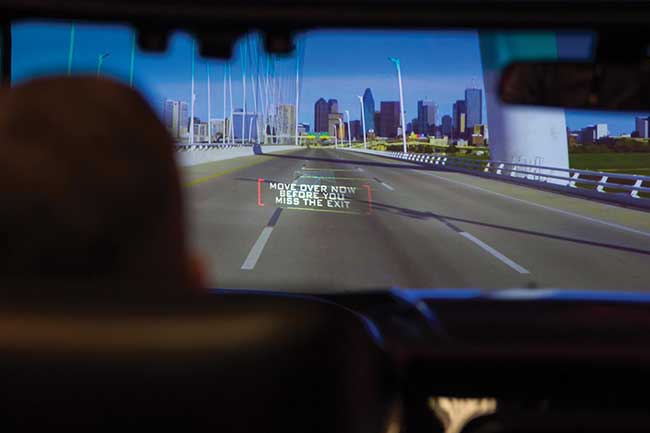
MEMS projection technology powers high-brightness and interactive head-up displays to enhance driving. Courtesy of Texas Instruments Inc.
“By using lasers with the MEMS, the display appears brighter than indicated simply by the ANSI [American National Standards Institute] lumens rating due to the intense contrast ratio of 80,000:1 and wide color gamut. Therefore, the products in the market with our technology are equivalent to LED-based displays with far higher lumens ratings,” Goetter said.
She noted that in addition to being used in a display, a MEMS-based technology can also be used for image capture. For example, coupling a red-green-blue laser with an infrared one would enable an image to be projected and interacted with by tracking where and when fingers touch the image.
Extensions of this sensing idea could include extracting three-dimensional information by creating patterns of light and imaging the result. Another use case is spectroscopy. This is possible because micromirrors are highly reflective, and therefore allow the manipulation of light ranging from the ultraviolet through the infrared.
Applications in augmented reality
As for the future, one potential application of MEMS-based displays is in augmented reality. As shown by the Pokémon GO craze, there is a great deal of interest, and possible market, for applications that overlay virtual digital information onto the real world.
Vuzix Corp. of Rochester, N.Y., makes augmented reality products that are incorporated into glasses and elsewhere. According to the company’s president, Paul Travers, Vuzix uses different display technologies but finds MEMS-based ones among the best because of their ability to deliver high contrast and brightness.
Augmented reality is already being used to speed picking parts out of a warehouse. A shipper or internet retailer, for instance, may have a large array of packages or products stored in a warehouse. When an order comes in, someone will be dispatched to retrieve the needed items. With augmented reality, the correct item can be highlighted as soon as its barcode is visible and the pick transaction automatically completed with limited need for user input. Reports indicate savings in retrieval time run 20 to 30 percent, according to Travers.
Another example comes from the world of air conditioning. A large industrial unit will have interlocks to protect the equipment. The knowledge of how to safely bypass these in all situations may only be available after years of hands-on experience. With augmented reality, even new technicians in the field can receive a marked-up real-time video feed detailing exactly how to trip thermal locks and gain access to the innards of an air conditioner in order to repair it in minutes instead of hours.
“That’s two hours of downtime saved by connecting the knowledge to do it anywhere, anytime,” Travers said.
Other companies are also turning to MEMS-based displays. One such company is Optecks LLC of Tulsa, Okla. An engineering firm, Optecks develops solutions using Texas Instruments’ DLP technology. Optecks’ recent projects include three-dimensional, near-eye displays, as well as 3D printing and 3D scanning applications, according to Hakki Refai, chief technical officer.
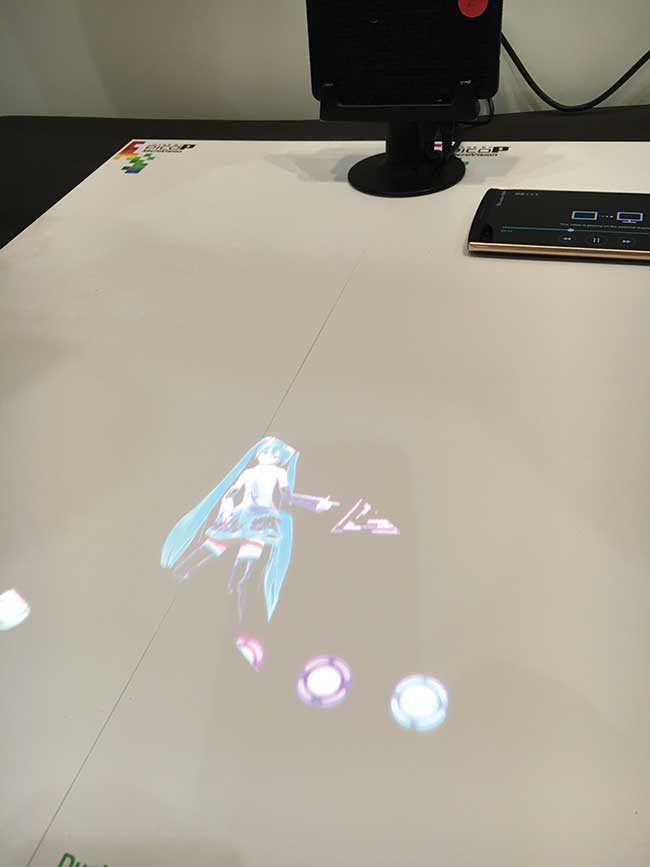
MEMS-based scanning technology enables tabletop projection. Smart projectors with integrated mobile operating systems could allow for interaction with the projected image. Courtesy of MicroVision Inc.
“The increased resolution in MEMS-based displays has significantly opened up the range of applications,” he said.
Refai pointed out that the optics design in these projects must account for the working distance, the image size desired, the depth of focus and other factors. Suppose the goal is to produce a large image at a short distance while maintaining image quality over several centimeters in depth for a 3D display application. That calls for particular choices with regard to lens focal lengths and positions of aperture stops, as well as lens shape and size. In contrast, another application may need to create an image at a much larger distance mainly at a single plane, such as projection onto a fixed screen. That calls for a different combination of optical elements.
In addition to near-eye displays, another likely future application of MEMS-based technology is in head-up displays, said Bob O’Brien, president of Austin, Texas-based Display Supply Chain Consultants LLC. For success, the display quality must be good over a wide range of conditions with systems that meet size and cost targets, O’Brien noted.
These head-up displays can be considered a version of augmented reality. By way of illustration, when giving directions, such a setup might include an arrow superimposed over the intersection where a turn should be made.
The possible market in head-up displays could be large and the growth rate high. Today less than a 10th of the 80 or so million cars sold worldwide annually have such a feature, O’Brien said. The situation, though, is expected to change rapidly, potentially benefiting MEMS-based technologies.
“Within five years you could see that going from less than 10 percent to somewhere between 20 and 30 percent having head-up displays. So from less than 5 million to somewhere in the15 to 25 million units per year. So that could be pretty substantial,” O’Brien said.